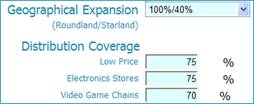Geographical expansion and distribution coverage
For each decision Round you must make two decisions regarding the distribution of your Red Ocean product.
Firstly, you must decide the portion of the total territory (both continents) that you want to cover. As explained in the manual, there are two broad geographic markets – like two continents: Roundland and Starland. The two markets are about the same size.
Roundland is the home country of all competitors and thus it is the market where new products are assumed to be launched first. Values input in Geographical expansion are in the form “R%/S%” where R% is the expansion in Roundland and S% the expansion in Starland. If you enter a value lower than or equal to “100%/0%”, your product will only be distributed in Roundland. Starland is much like Europe with multiple languages and countries. Geographic expansion into this latter market starts when you enter a value of “100%/10% or more.

Secondly, you must decide the distribution coverage for each of the three distribution channels:
• Low Price-orientated Channels
• Specialized Electronic Stores
• Video Game Chains.
The distribution coverage is a measure of the percentage of stores where your product will be available as well as the quantity and quality of the shelf-space allocated to your product (gondola heads or eye-level premium shelf-space).
Based on these two decisions, your Sales department will automatically calculate the cost of your sales force. This cost includes the salaries and benefits of sales people, the point-of-sales materials, promotional items, participations to trade-shows, etc. You will quickly realize that sales force is costly; for instance, the budget required to cover 100% of the territory and 100% of stores in all three channels would be close to 300 million dollars. You thus have to make choices in order to remain within your allocated budget. You will most likely concentrate your efforts on the channels where your target customers shop. Refer to the “shopping preferences” chart that is presented in the handbook.